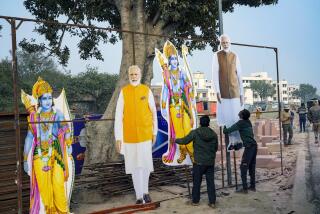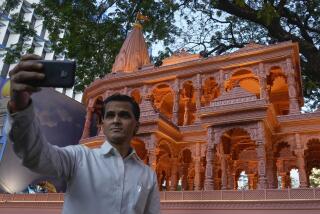India braces for Babri Masjid ruling
- Share via
Reporting from New Delhi — When Muslims and Hindus went on a rampage in the early 1990s after a mosque in the northern Indian town of Ayodhya was demolished by extremist Hindus, the violence sent political shock waves across India.
On Friday, in one of the most anticipated decisions in memory, the Allahabad High Court is set to issue a ruling on a legal dispute that began 60 years ago over who owns the underlying property, which could lead to the Babri Masjid being rebuilt or a Hindu temple erected.
In the run-up, hard-line Hindu groups have organized awareness campaigns and hymn programs to Hanuman, the monkey god and associate of Rama, a deity who many Hindus believe was born at the site in Ayodhya.
Though the issue appears to have lost some of its political potency, the state, mindful of the sectarian violence in 1992 that killed 2,000 people nationwide, isn’t taking any chances with security.
Uttar Pradesh state, where Ayodhya is located, has mobilized 40,000 security personnel, while the capital, Delhi has, cancelled ministers’ trips and dispatched 5,200 paramilitary to the area. Other states are on alert, with particular focus on 32 “communally sensitive cities,” including Mumbai, even as water cannons are stockpiled, cellphone text messages monitored and schools earmarked as potential jails.
“The real question is whether we’ve outlived that time of violence,” said Mahesh Rangarajan, a political historian at Delhi University.
An eruption of violence could further dent India’s image as foreign media arrive in the capital to cover the Oct. 3-14 Commonwealth Games. The sporting event is already marred by corruption allegations, a footbridge that collapsed during construction, various other structural problems, and poor planning and management. A last-minute motion to delay Friday’s verdict is not expected to succeed.
Political analysts and citizens hope India’s economic and social tensions have eased relative to the early 1990s. Citizens are now better educated and India’s lower and middle classes enjoy upward mobility amid an economic boom and growing national pride.
“I don’t think there will be any riots this time around, although there may be protests,” said Pawan Singh, 48, who runs an Ayodhya inn. “The anger on both sides has relented.”
These days, many hard-line Hindu leaders balk at reigniting communal passions. “The younger generation of politicians is much less invested in this,” said Pratap Mehta, president of New Delhi’s Center for Policy Research.
Hindu and Muslim groups have pledged to operate within the law and the likely option of filing a Supreme Court appeal should blunt anger on the losing side.
The case, which combines four Hindu and Muslim lawsuits filed between 1950 and 1989, is epic even by India’s creaky legal standards, with many of the 6,000 witnesses and original litigants dead. An appeal will add more time.
“The Supreme Court can decide in a year, but they could also take 15 years,” said Zafaryab Jilani, a lead attorney representing Muslim litigants.
In addition to land-ownership issues, a related and highly emotional matter before the court is whether Ram, one of Hinduism’s most important gods (and technically a plaintiff) was born at the site.
If the court has any sense, it won’t touch that question with a 10-foot pole, said Soli Sorabjee, a former attorney general. “It’s like ruling on whether Jesus existed or not,” he said. “It’s absurd.”
Ayodhya has remained relatively calm throughout the dispute with many locals keen to move on. The town of 50,000, which houses over 1,000 temples, several claiming to be Ram’s birth site, and a dozen or so mosques, has seen no religious violence even in 1992, and today boasts cyber cafes, call centers and English-language schools.
Some have even proposed the land be used for a hospital or a shrine to victims of religious violence.
As with other contested sites worldwide, the Babri Masjid’s history is rather opaque. The mosque was built in 1528 by a commander of Mughal Emperor Babar [1483-1530] on land known as Ram Janambhoomi to Hindus. It was long beloved by both faiths for the sweet, medicinal waters from a well in the central courtyard.
At some point, belief spread among Hindus that a Ram temple had been destroyed to build the Babri Masjid, said local historian Sushil Srivastava, although the archeological evidence is inconclusive.
In 1853, in the first record of religious tension, both sides laid claim to the site, so a fence was built restricting Muslims to the inner and Hindus the outer part.
The current conflict dates to 1949 when zealots planted Hindu idols in the inner mosque on the night of Dec. 22-23 — hailed by Hindu crowds as a miracle. When Muslims protested, the state ruled it a disputed site and locked it up.
Things remained relatively quiet until 1986 when Prime Minister Rajiv Gandhi’s government, keen to curry votes, reportedly pressured the judiciary to open it to Hindu worshipers. The cause was taken up by the Hindu nationalist Bharatiya Janata Party, leading to the well-planned 1991 demolition, though supporters insisted it was a spontaneous act. In the mosque’s place, a makeshift temple stands today, although pledges to build a magnificent Ram temple were never realized.
“People are very aware and conscious of history,” said Parul D. Mukherji, a professor at the Jawaharlal Nehru University. “They don’t want the same mistakes repeated.”
mark.magnier@latimes.com
Anshul Rana in The Times’ New Delhi Bureau contributed to this report.
More to Read
Sign up for Essential California
The most important California stories and recommendations in your inbox every morning.
You may occasionally receive promotional content from the Los Angeles Times.










